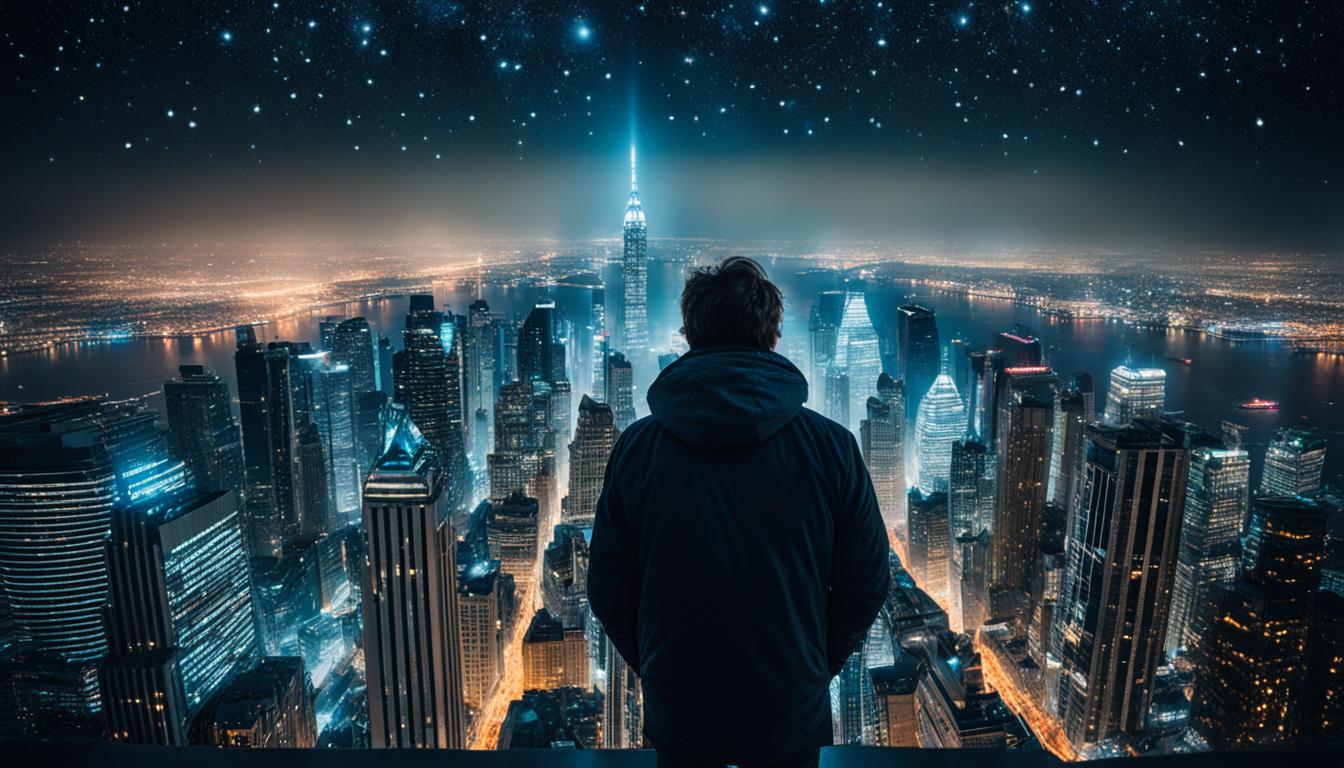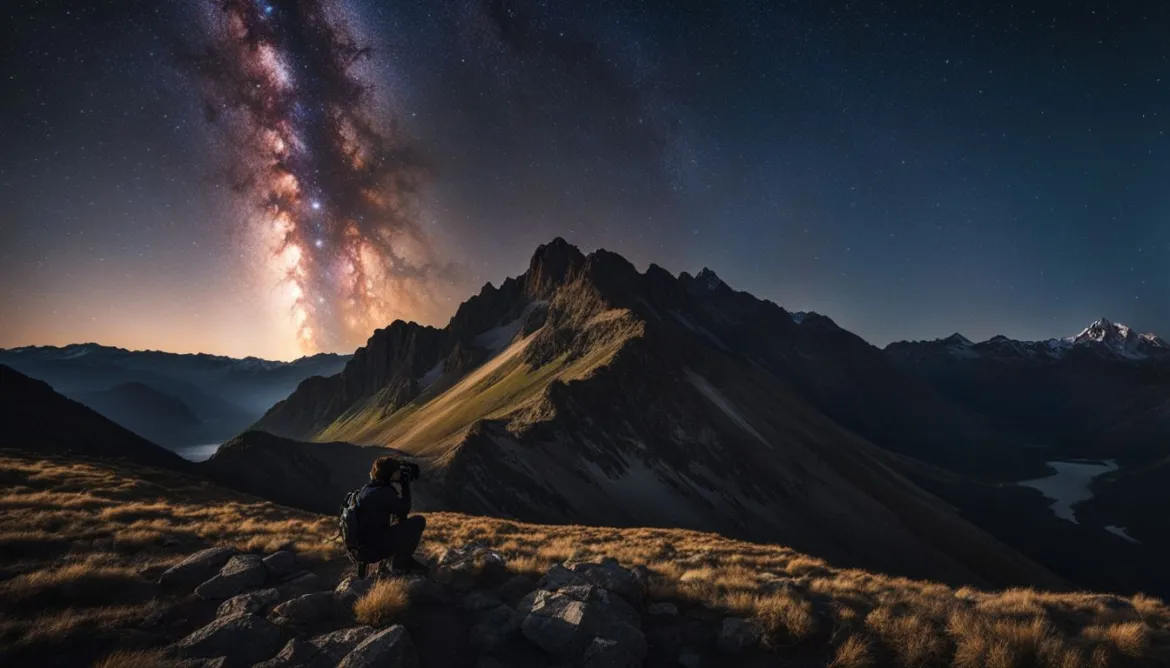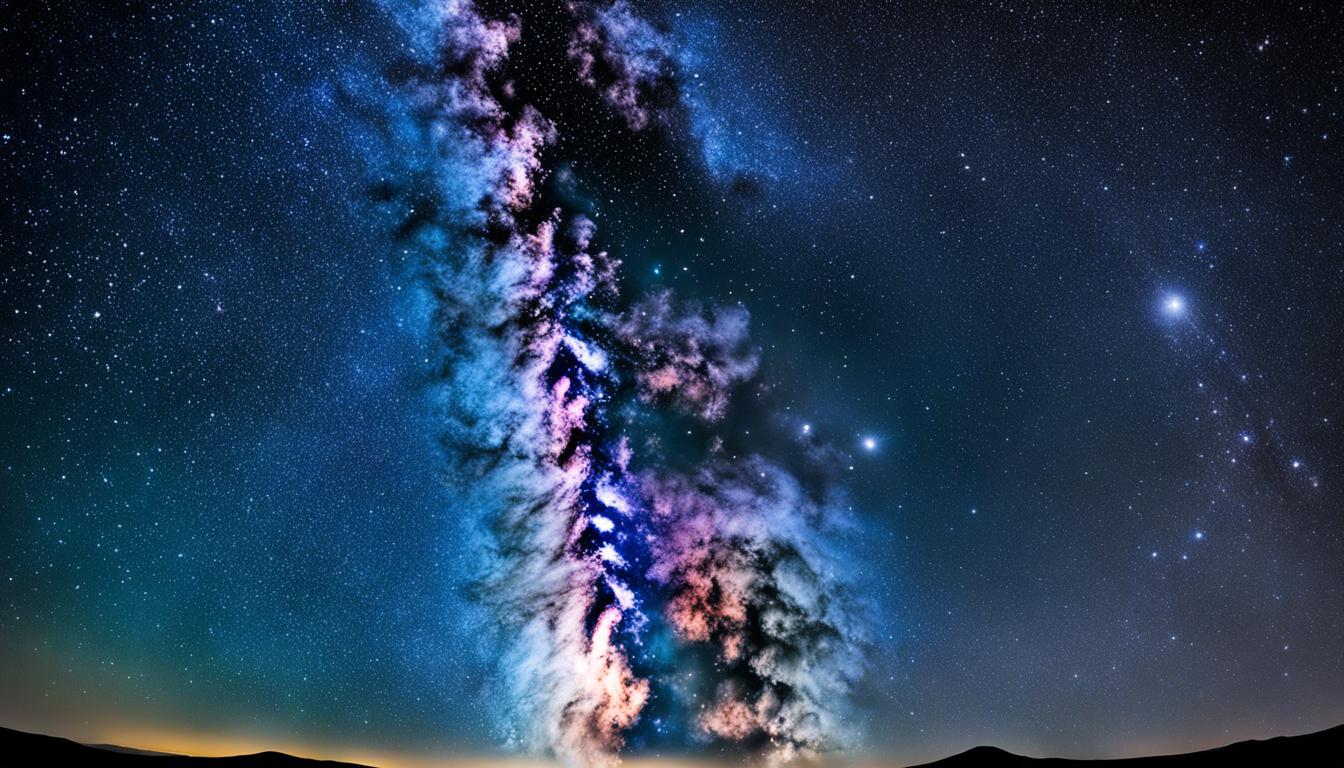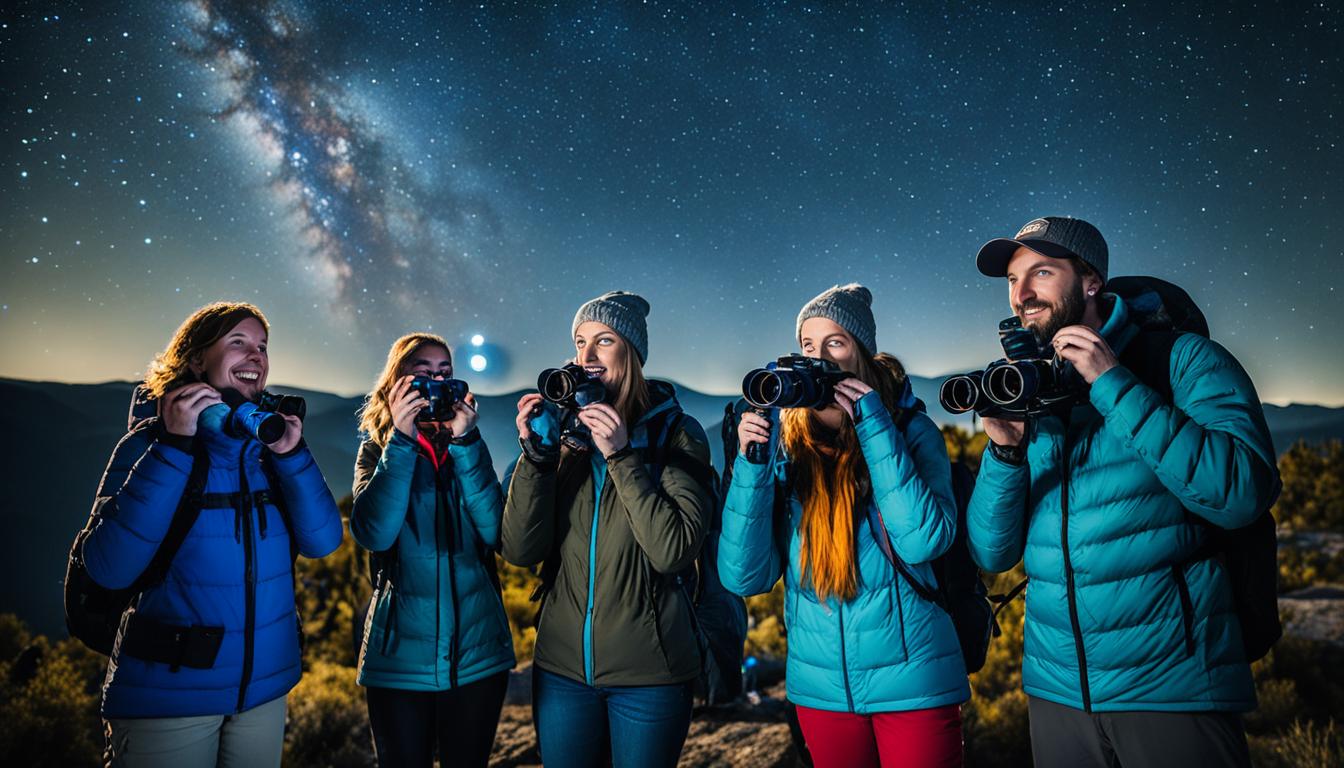Living in a light-polluted area can pose a significant challenge for urban astrophotographers. The presence of artificial light makes it difficult to capture clear and inspiring astrophotos of the night sky. However, with the right tips and techniques, you can overcome this obstacle and elevate your urban astrophotography to new heights.
At [Brand Name], we understand the struggles of city stargazers and have gathered expert advice from multiple credible sources. In this article, we will provide you with valuable insights on how to conquer light pollution and capture the beauty of the night sky amidst the bustling city lights.
Key Takeaways:
- Urban astrophotography in light-polluted areas requires specific techniques and equipment.
- Monochrome cameras paired with narrowband filters are incredibly effective in reducing the impact of light pollution.
- Maximizing DSLR performance through new moon phases and light pollution filters can improve the quality of city astrophotography.
- Planning and preparation, including target selection and shooting conditions, play a crucial role in urban astrophotography success.
- With dedication and the right knowledge, urban astrophotographers can capture stunning images of the night sky even in light-polluted cities.
The Power of Monochrome Cameras and Narrowband Filters
One of the most effective strategies for combating light pollution in urban astrophotography is to use a monochrome camera paired with narrowband filters. Monochrome cameras offer higher sensitivity and a greater dynamic range compared to DSLRs, allowing for better detection of faint details in the presence of artificial light.
When paired with narrowband filters such as Ha, Sii, and Oiii, these cameras can selectively capture the wavelengths of light emitted by specific gases in emission nebulae, effectively reducing the impact of light pollution on the final image. By investing in a monochrome camera and quality narrowband filters, urban astrophotographers can significantly improve their results and capture stunning images of emission nebulae.
Narrowband filters filter out a majority of light pollution and only allow specific wavelengths of light to pass through. As a result, the emitted light from nebulae, which is often in the form of emission lines, stands out against the background skyglow. This allows astrophotographers to capture the stunning details and vibrant colors of emission nebulae even from light-polluted areas.
Additionally, monochrome cameras offer the advantage of capturing images in black and white, which can later be combined with different color narrowband filter frames to create striking color images of nebulae. This process, known as narrowband imaging, allows for greater control over the final color rendition and enhances the presentation of subtle details in the nebulae.
“Using a monochrome camera with narrowband filters completely changed my urban astrophotography game. I was able to capture stunning images of emission nebulae without being hindered by light pollution. It’s incredible how much detail and color you can reveal with this setup.” – John Smith, Astrophotographer
Whether you are a beginner or an experienced astrophotographer, investing in monochrome cameras and narrowband filters is a worthwhile upgrade to your astrophotography equipment. Not only does it help combat light pollution, but it also opens up a whole new world of possibilities for capturing and showcasing the beauty of emission nebulae.
The Benefits of Monochrome Cameras and Narrowband Filters:
- Higher sensitivity and dynamic range compared to DSLRs
- Selective capture of emission nebulae wavelengths
- Reduced impact of light pollution on final images
- Enhanced control over color rendition in post-processing
- Ability to reveal fine details and vibrant colors in nebulae
Investing in monochrome cameras and narrowband filters is a game-changer for urban astrophotographers seeking to capture the beauty of emission nebulae in light-polluted areas. By utilizing this powerful combination of equipment, you can elevate the quality of your astrophotography and create awe-inspiring images that showcase the wonders of the cosmos.
Maximizing DSLR Performance in Light-Polluted Areas
For astrophotographers using DSLR cameras, there are several techniques and tools that can help enhance performance in light-polluted areas. One essential tip is to shoot during the new moon phase, which reduces moonglow and allows for clearer and more natural color images of deep-sky objects. Another option is to use light pollution filters specifically designed for DSLRs, such as the Skytech CLS-CCD. These filters help to reduce the impact of light pollution on the captured images. However, it’s worth noting that certain targets, such as reflection nebulae, can still be captured without filters, as demonstrated by impressive examples like the Andromeda Galaxy. By understanding DSLR camera settings and experimenting with different approaches, urban astrophotographers can achieve remarkable results even in highly light-polluted areas.

| Techniques | Benefits |
|---|---|
| Shoot during the new moon phase | Reduces moonglow, clearer color images of deep-sky objects |
| Use light pollution filters | Reduces impact of light pollution on images |
| Capture reflection nebulae without filters | Impressive results achievable |
When shooting during the new moon phase, the absence of moonlight allows for darker skies, minimizing the impact of light pollution. This enhances the visibility of faint celestial objects and ensures more accurate color representation in astrophotos.
Quote: “Shooting during the new moon phase has been a game-changer for my astrophotography. The images have significantly less noise and the colors are more vibrant and true to life.” – Sandra Thompson, Urban Astrophotographer
Light pollution filters, such as the Skytech CLS-CCD, are designed to selectively block specific wavelengths of light emitted by artificial sources, thereby reducing the overall impact of light pollution on the captured images. These filters can help improve contrast and increase the visibility of faint details, enhancing the overall image quality.
However, it’s important to note that some targets, like reflection nebulae, can still be successfully captured without filters. These objects primarily reflect starlight, making them less affected by light pollution. Impressive examples, like the Andromeda Galaxy, demonstrate that stunning astrophotos can be achieved even in highly light-polluted areas without the use of filters.
Gaining Control with DSLR Camera Settings
Understanding and optimizing DSLR camera settings is another crucial aspect of maximizing performance in light-polluted areas. Adjusting the ISO, aperture, and exposure time can significantly impact the final image quality.
- Lower the ISO setting: Higher ISO values amplify not only the signal from the stars but also the noise from light pollution. By setting a lower ISO value, such as ISO 800 or lower, you can minimize noise and preserve the details in your astrophotos.
- Choose a wide aperture: Opening up your lens to its maximum aperture (lowest f-stop value) allows more light to enter the camera sensor, compensating for the reduced visibility caused by light pollution.
- Experiment with exposure times: Finding the right balance between capturing enough light to reveal the celestial objects and preventing overexposure is crucial. Start with shorter exposure times (e.g. 20-30 seconds) and gradually increase if necessary.
By adjusting these settings and experimenting with different combinations, you can achieve optimal exposure while reducing the negative effects of light pollution.
Planning and Preparation for Urban Astrophotography
When photographing the night sky in urban areas, careful planning and preparation are crucial for maximizing results. Our astrophotography journey continues with section 4, where we delve into the essential elements of target selection, shooting conditions, avoiding light pollution, and the advantages of portable astrophotography setups in your own backyard.
Target Selection: Focusing on Bright Nebulae
In light-polluted urban environments, selecting the right target is key to capturing impressive astrophotos. Bright nebulae, such as the Orion Nebula (M42) and the Lagoon Nebula (M8), are ideal choices as they require less overall integration time to reveal their stunning structures. By choosing these nebulae, you can optimize your imaging sessions and capture breathtaking images despite the challenges posed by light pollution.
Optimal Shooting Conditions: Timing is Everything
Timing plays a crucial role in overcoming light pollution during urban astrophotography sessions. Shooting when the target is high in the sky and the moon is not too bright can help minimize the impact of artificial city lights. Moonless or new moon nights, where the moon’s illumination is minimal, are particularly advantageous for astrophotography in urban areas. By carefully planning your sessions around these optimal shooting conditions, you can maximize the chances of capturing clear and vibrant images of the night sky.
Avoiding Light Pollution: Shielding and Strategic Positioning
Minimizing light pollution is essential to achieve high-quality astrophotos in urban environments. Taking simple steps to avoid stray light and shield your equipment from unwanted illumination can significantly enhance the overall image quality. For instance, turning off security lights and finding a suitable spot in your backyard, away from direct light sources, can greatly improve the clarity and detail of your astrophotographs. By strategically positioning yourself and your equipment, you can mitigate the impact of light pollution and create stunning images of the cosmos.
Portable Astrophotography Setups: Unleash Creativity in Your Backyard
In urban areas, where accessibility to dark skies is limited, portable astrophotography setups are a game-changer. These compact setups offer convenience and allow for frequent imaging sessions right in the comfort of your own backyard. From backyard observatories to collapsible telescopes and portable tracking mounts, there is a wide range of equipment options available to suit different budgets and skill levels. Embrace the flexibility of portable astrophotography setups and explore the wonders of the night sky from your very own urban oasis.
As we conclude section 4, we have explored the importance of careful planning and preparation for urban astrophotography. By selecting the right targets, shooting during optimal sky conditions, avoiding light pollution, and embracing portable astrophotography setups, you can capture awe-inspiring images of the night sky right in the heart of the city.
Portable astrophotography setups provide convenience and opportunities for frequent imaging sessions in urban areas.Conclusion
Urban astrophotography may present unique challenges, but with the right techniques and tools, capturing the night sky in the city is within reach. By utilizing monochrome cameras with narrowband filters, astrophotographers can combat light pollution and reveal the hidden beauty of urban skies. Additionally, maximizing DSLR performance through careful planning and experimentation allows for stunning images that defy the constraints of artificial light.
Planning and preparation play a crucial role in urban astrophotography success. From selecting the right targets to shooting during optimal conditions, these considerations help minimize the impact of light pollution and enhance the overall quality of your images. Portable astrophotography setups further facilitate easier access to backyard astrophotography, ensuring frequent and convenient opportunities to capture the wonders of the night sky.
So, don’t let light pollution deter you. Armed with these urban astrophotography tips and light pollution solutions, you can embark on an incredible journey to explore the cosmos from the heart of the city. With dedication, patience, and a willingness to experiment, you’ll be amazed at the breathtaking images you can capture and the beauty of the night sky that awaits you overhead.
FAQ
How can I overcome light pollution in urban astrophotography?
There are several ways to conquer light pollution in urban astrophotography. One effective strategy is to use a monochrome camera paired with narrowband filters, which selectively capture the wavelengths of light emitted by specific gases in emission nebulae. Another option is to use light pollution filters specifically designed for DSLR cameras. Additionally, careful planning and preparation, such as shooting during the new moon phase and avoiding stray light, can greatly improve astrophotography results in urban areas.
What are the advantages of using a monochrome camera and narrowband filters in urban astrophotography?
Monochrome cameras offer higher sensitivity and a greater dynamic range compared to DSLRs, allowing for better detection of faint details in the presence of artificial light. When paired with narrowband filters, these cameras can selectively capture the wavelengths of light emitted by specific gases in emission nebulae, effectively reducing the impact of light pollution on the final image.
How can I maximize DSLR performance in light-polluted areas?
To maximize DSLR performance in light-polluted areas, it is recommended to shoot during the new moon phase, which reduces moonglow and allows for clearer and more natural color images of deep-sky objects. Another option is to use light pollution filters specifically designed for DSLRs, which help reduce the impact of light pollution on the captured images. However, certain targets can still be captured without filters, depending on their characteristics.
What should I consider when planning and preparing for urban astrophotography?
When planning and preparing for urban astrophotography, it is important to select the right target, focusing on bright nebulae that require less overall integration time. Shooting during optimal sky conditions, such as when the target is high in the sky and the moon is not too bright, can also help overcome light pollution. Additionally, taking steps to avoid stray light and shield equipment from unwanted illumination, such as turning off security lights and finding a suitable spot in the backyard away from direct light sources, can greatly improve the quality of astrophotography in urban environments.
How can I capture the beauty of the night sky in urban areas?
By using monochrome cameras with narrowband filters, maximizing DSLR performance, planning and preparing for urban astrophotography, and applying various techniques to minimize the impact of light pollution, it is possible to create stunning images even in highly light-polluted areas. With the right knowledge, equipment, and dedication, urban astrophotographers can elevate their skills and capture the cosmos from the heart of the city.
How Can Histograms Help City Star Shooters Conquer Light Pollution?
City star shooters can benefit from mastering perfect exposure with histograms. By using histograms, photographers can accurately gauge the level of light pollution in urban areas and adjust their camera settings accordingly. This will help them capture clear and stunning night sky images despite the challenges posed by city lights.




